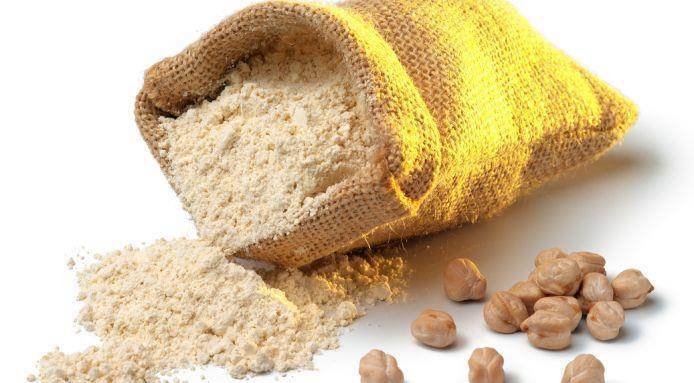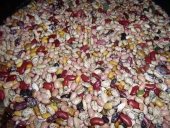
 2
2




Grinding Gluten-Free Flour from Pulses
You can grind your own flour from pulses useing a blender or flour mill...
Each pulse offers a slightly different texture and flavour of flour. choose from chickpeas, lentils or small beans. You can also experiment with roasting your pulses first - no more than 20 minuites at 350F - to ease the grinding and give your flour a nuttier flavour. Or roast the flour itself in the oven in an uncovered cast iron frying pan for a simular amount of time ot enrich its flavour, stirring with a fork every 3 to 4 minutes so that it browns evenly.
After grinding, store your pulse flour in an airtight container in a coll and dry place, or freeze to keep it super-fresh.
...
Chickpea flour (also called besan or gram flour) is by far the most popular...

Another bean cooking fail that I see from time to time, is that someone grinds up dry beans to make flour, then they use the flour to make bread... That really accentuates the taste of the bean poison to me. Breads just don't get hot enough to deactivate the poison. So whenever anyone tells me that they are going to add beans to a bread, I recommend that they cook the beans first, and then mash them before adding to the bread.








 1
1




R Ranson wrote:However, I wonder... there are cultures that traditionally use bean and chickpea flours. What do they do to get rid of that poison taste?
R Ranson wrote:Once I do make chickpea flour, what recipes can I use it in?
 1
1






“The most important decision we make is whether we believe we live in a friendly or hostile universe.”― Albert Einstein











 2
2





Meet the New Must-Have-It Pantry Staple: Chickpea Flour
Why make chickpea flour your new go-to? Because everyone—gluten-free or not—will find a reason to love it. This versatile alternative to wheat flour shines in savory and sweet dishes alike. It’s been used for centuries around the world, and is famous in Nice, France, where the flatbread socca is enjoyed with a chilled glass of rosé.
In this gorgeously photographed cookbook, Lindsey S. Love takes inspiration from her favorite seasonal ingredients, global flavors, and much-loved family recipes to create vibrant gluten-free, dairy-free, and vegetarian dishes where chickpea flour is the star. Gluten-free diners especially will be amazed by the variety—nothing’s off the table anymore, and taste is never sacrificed. Plus, many recipes are vegan—taking advantage of chickpea flour as a base for vegan sauces and a soy-free alternative to tofu.
Lindsey’s inventive recipes meld sophisticated and subtle flavors—and beg to be shared with friends and family at any time of the year!
Toast It, Sift It, Simmer It . . . Chickpea Flour Does It All:
Thickens and flavours hearty dishes like Sunchoke and Leek Soup
Gives any dish a protein boost, even Vanilla Bean Lavender Cupcakes
Adds creamy texture to dairy-free dishes, such as Loaded Sweet Potatoes with Chickpea Sour Cream
And brings back family favorites—now gluten-free—like pizza (Chickpea Pizza with Asparagus and Pea Shoot Tangle) and pancakes (Sautéed Pear and Sage Pancakes with Almonds)!







 2
2











 1
1















http://www.popcliq.com (web development), GoPermaculture Food Forest http://www.permies.com/t/57687/forest-garden/Permaculture-Food-Forest-suburban-permaculture, Sea Buckthorn (Seaberry) grower (hobbiest) https://www.facebook.com/michelle.bisson.37, zone 3b/4b (borderline) Quebec Canada

 2
2




Works at a residential alternative high school in the Himalayas SECMOL.org . "Back home" is Cape Cod, E Coast USA.
 1
1





 1
1




Hans Albert Quistorff, LMT projects on permies Hans Massage Qberry Farm magnet therapy gmail hquistorff
 1
1




 1
1











 1
1




 1
1





 2
2




QuickBooks set up and Bookkeeping for Small Businesses and Farms - jocelyncampbell.com
 2
2




Jocelyn Campbell wrote:What if you roasted cooked (you know, soaked, then rinsed, then fully cooked) chick peas until dry and crunchy, season and eat some as a delightful snack, and try grinding some of those into flour? Of course far more labor intensive, but if you're cooking up a batch for something else any way, perhaps not so onerous.
From 20+ years of gluten-free baking, chickpea flour, while surprisingly common in GF baked goods, has always been one of my least favorite flours. Though I love the chick pea and other bean flours in the various Indian dishes. I hadn't realized it was the poison taste, and the different in high heat versus lower baking heat things, though that makes such "d'oh!!" sense now!




 2
2




Standing on the shoulders of giants. Giants with dirt under their nails
 2
2




 2
2




Standing on the shoulders of giants. Giants with dirt under their nails
 3
3








Argue for your limitations and they are yours forever.
 1
1




Mike Barkley wrote:I'm wondering how cooked chickpeas that were then dehydrated into thin layers would perform in a grinder or molcajete. Dehydrator experiment waiting to happen.
Gardens in my mind never need water
Castles in the air never have a wet basement
Well made buildings are fractal -- equally intelligent design at every level of detail.
Bright sparks remind others that they too can dance
What I am looking for is looking for me too!





 1
1




Gardens in my mind never need water
Castles in the air never have a wet basement
Well made buildings are fractal -- equally intelligent design at every level of detail.
Bright sparks remind others that they too can dance
What I am looking for is looking for me too!

 1
1





|
They worship nothing. They say it's because nothing lasts forever. Like this tiny ad:
Freaky Cheap Heat - 2 hour movie - HD streaming
https://permies.com/wiki/238453/Freaky-Cheap-Heat-hour-movie
|








